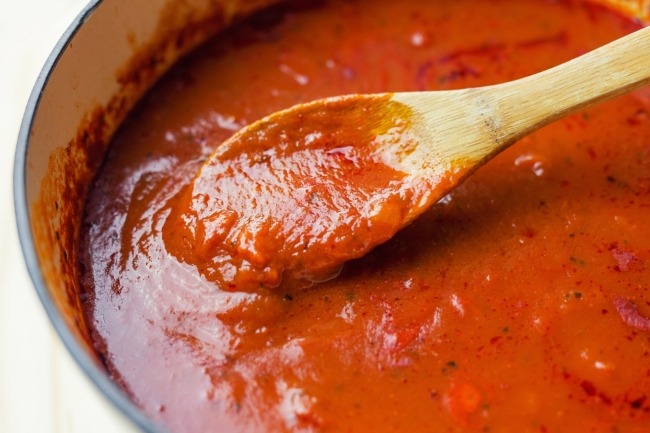Classic Italian Tomato Sauce Recipe: The Ultimate Guide to Making Authentic Marinara Sauce
Italian cuisine is celebrated worldwide for its simplicity, flavor, and the love that goes into every dish. At the heart of many Italian recipes is a rich, savory tomato sauce, known as marinara. This classic sauce forms the foundation of numerous Italian dishes, from pasta and pizza to lasagna and parmigiana. Today, we delve into the art of crafting a traditional Italian tomato sauce that will transport your taste buds straight to the sun-soaked hills of Tuscany.
Ingredients and Their Role
Before diving into the preparation, let’s take a closer look at the ingredients that make this sauce truly special:
- Whole, Peeled Tomatoes (1 can, 28 oz.): Tomatoes are the soul of this sauce. Opt for high-quality canned tomatoes, preferably San Marzano, known for their sweetness and low acidity. These tomatoes provide a robust base flavor and a smooth texture.
- Olive Oil (1/4 cup): Olive oil adds richness and helps to sauté the onions and garlic, infusing the sauce with their flavors. Extra virgin olive oil is recommended for its superior taste and health benefits.
- Onion (1/2 cup, diced): Onions add a subtle sweetness and depth to the sauce. They break down during cooking, blending seamlessly with the tomatoes.
- Garlic (7 cloves, minced): Garlic is a cornerstone of Italian cuisine, offering a pungent, aromatic quality that enhances the overall flavor profile of the sauce.
- Red Pepper Flakes (1/4 teaspoon): These add a hint of heat, balancing the sweetness of the tomatoes and the richness of the olive oil.
- Dried Oregano (1/2 teaspoon): Oregano brings a slightly bitter, earthy flavor that complements the sweetness of the tomatoes.
- Kosher Salt (1 teaspoon): Salt enhances all the flavors, bringing them together in perfect harmony.
- Fresh Basil (1 sprig): Basil adds a fresh, peppery note, infusing the sauce with its unmistakable aroma and flavor as it simmers.
Step-by-Step Preparation
1. Preparing the Tomatoes
Start by preparing the tomatoes. Pour the canned whole, peeled tomatoes into a large bowl. Using your hands, crush the tomatoes gently to release their juices. This rustic method of breaking down the tomatoes ensures a chunky texture that is characteristic of a good marinara sauce.
2. Sautéing the Aromatics
Heat the olive oil in a large pan or skillet over medium-high heat. Add the diced onions and cook until they are softened and translucent, which should take about 8-10 minutes. The goal here is to sweat the onions, allowing them to release their natural sugars and develop a sweet, caramelized flavor.
During the last 1-2 minutes of cooking the onions, add the minced garlic. Stir frequently to prevent the garlic from burning. You’ll know it’s ready when your kitchen is filled with the fragrant aroma of sautéed garlic.
3. Building the Sauce
Once the onions and garlic are perfectly sautéed, it’s time to add the crushed tomatoes. Pour them into the pan and stir well to combine. Add the red pepper flakes, dried oregano, and kosher salt. These spices will enhance the flavor of the tomatoes, adding depth and complexity to the sauce.
Lay the sprig of fresh basil on top of the tomatoes. As the sauce simmers, the basil will wilt, releasing its aromatic oils and infusing the sauce with its fresh, peppery flavor.
4. Simmering the Sauce
Allow the sauce to simmer gently for about 15 minutes. This simmering time is crucial as it allows the flavors to meld together and the sauce to thicken slightly. Stir occasionally to prevent the sauce from sticking to the bottom of the pan and burning.
5. Final Touches
After 15 minutes, the sauce should be rich and fragrant. Remove the basil sprig and discard it. Taste the sauce and adjust the seasoning if necessary. You may want to add a little more salt or a pinch of sugar if the tomatoes are too acidic.
Serving Suggestions
This classic Italian tomato sauce is incredibly versatile and can be used in a variety of dishes. Here are a few serving suggestions to get you started:
- Over Pasta: This sauce is perfect over a bowl of al dente spaghetti, penne, or any pasta shape of your choice. Top with freshly grated Parmesan cheese and a drizzle of olive oil for a simple yet satisfying meal.
- As a Pizza Sauce: Spread this sauce over your pizza dough before adding your favorite toppings. The rich tomato flavor pairs wonderfully with mozzarella, pepperoni, mushrooms, and more.
- In Lasagna: Use this sauce as a layer in your homemade lasagna. It complements the layers of pasta, ricotta cheese, and ground meat beautifully.
- For Chicken Parmigiana: Coat chicken cutlets in breadcrumbs and fry until golden. Top with this sauce and mozzarella cheese, then bake until bubbly and delicious.
- With Meatballs: Simmer meatballs in this sauce for a hearty and comforting dish. Serve with crusty bread to soak up every last drop.
Classic Italian tomato sauce Recipe
Ingredients
- 1 can (28 oz.) whole, peeled tomatoes
- 1/4 cup olive oil
- 1/2 cup onion, diced
- 7 cloves garlic, minced
- 1/4 teaspoon red pepper flakes
- 1/2 teaspoon dried oregano
- 1 teaspoon kosher salt
- 1 sprig fresh basil
Preparation
- Pour tomatoes into a bowl, and crush them with your hands to release the juices.
- Heat olive oil in a large pan or skillet over medium-high heat. Cook onion until softened and translucent, 8-10 minutes. During the last 1-2 minutes of cooking, add garlic and cook, stirring frequently, until fragrant.
- Add tomatoes to saucepan, then stir in red pepper flakes, oregano, and salt.
- Lay sprig of basil on top of tomatoes, and let it wilt as sauce cooks. Simmer for 15 minutes.
- Discard basil sprig, and serve over cooked pasta.
Tips for the Best Tomato Sauce
Creating the perfect tomato sauce is both an art and a science. Here are some tips to ensure your sauce is the best it can be:
- Use Quality Ingredients: The quality of your tomatoes, olive oil, and fresh basil will significantly impact the final flavor of your sauce. Invest in the best ingredients you can find.
- Don’t Rush the Process: Allow the sauce to simmer slowly. This patience will be rewarded with a deeply flavored, well-balanced sauce.
- Season Carefully: Taste your sauce as it cooks and adjust the seasoning as needed. A pinch of sugar can balance acidity, and a little extra salt can enhance flavors.
- Customize to Your Taste: Feel free to tweak the recipe to suit your preferences. Add more garlic for a stronger flavor, or increase the red pepper flakes for more heat.
Storing and Reheating
This sauce can be made ahead and stored in the refrigerator or freezer for later use. Here’s how:
- Refrigerator: Store in an airtight container for up to 5 days. Reheat on the stovetop over medium heat until warmed through.
- Freezer: Allow the sauce to cool completely before transferring to freezer-safe containers or zip-top bags. It can be frozen for up to 3 months. Thaw in the refrigerator overnight before reheating.
Making your own classic Italian tomato sauce from scratch is a rewarding and delicious experience. With a few simple ingredients and a bit of time, you can create a sauce that is rich, flavorful, and far superior to anything you can buy in a store. Whether you’re using it to top a plate of pasta, spread on a pizza, or layer in a lasagna, this sauce will become a staple in your kitchen. Enjoy the process and savor the results – buon appetito!
FAQ
Q: Can I use fresh tomatoes instead of canned?
A: Yes, you can use fresh tomatoes if you prefer. Blanch and peel them before crushing to remove the skins. Keep in mind that canned tomatoes, especially San Marzano, are often used for their consistent flavor and texture.
Q: How can I make the sauce thicker?
A: If you prefer a thicker sauce, you can simmer it for a longer period to reduce the liquid. Alternatively, you can add a tablespoon of tomato paste during the sautéing of the onions and garlic for a thicker consistency.
Q: Is it necessary to remove the basil sprig?
A: The basil sprig is used to infuse the sauce with flavor. Removing it after simmering prevents the basil from becoming too overpowering. If you enjoy a stronger basil flavor, you can chop and add fresh basil leaves instead.
Q: Can I add other herbs and spices?
A: Absolutely! Feel free to experiment with other herbs and spices such as thyme, rosemary, or bay leaves to customize the sauce to your liking.
Q: What type of pasta pairs best with this sauce?
A: This sauce is versatile and pairs well with many types of pasta. Spaghetti, penne, fusilli, and rigatoni are all excellent choices.
Creating a classic Italian tomato sauce is a culinary journey that brings the flavors of Italy to your kitchen. With this detailed guide, you’re well-equipped to make a sauce that will impress family and friends. Happy cooking!








